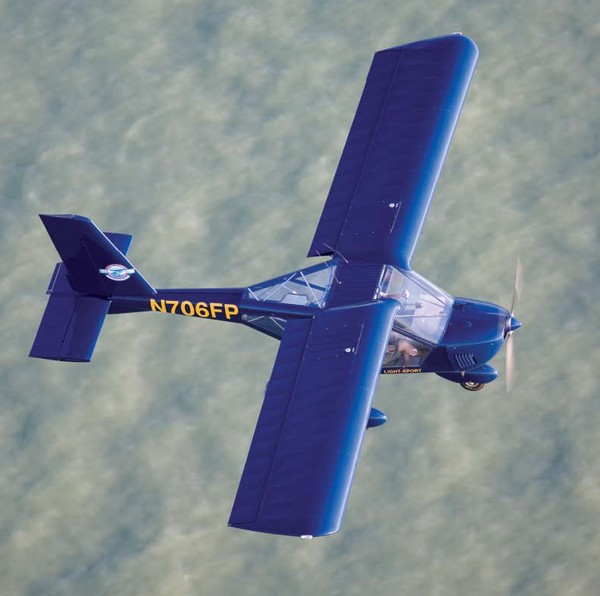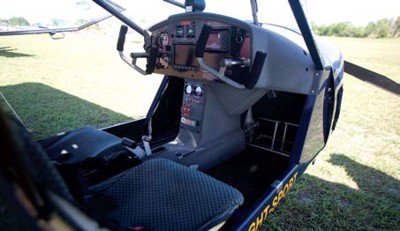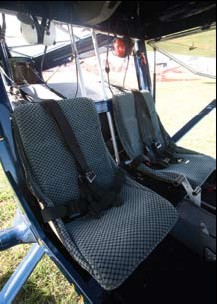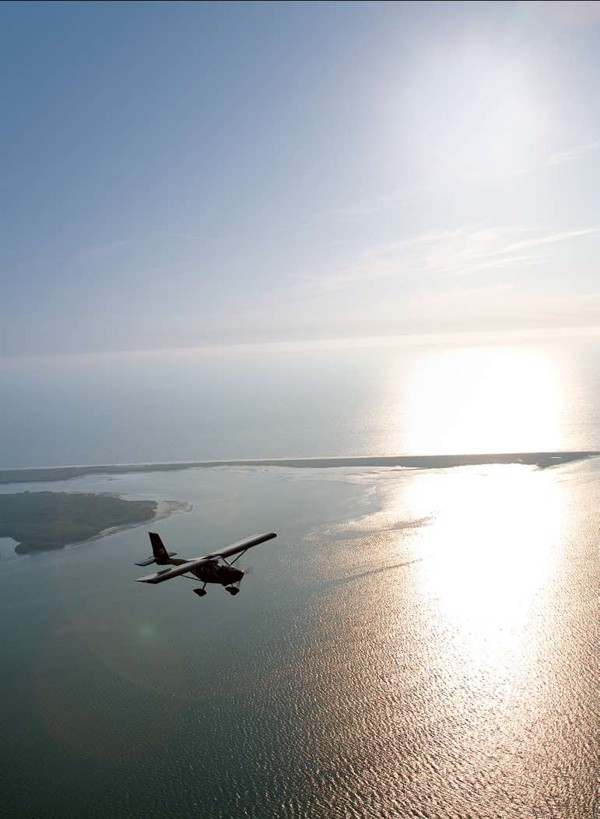
Visibility is tops in the A-22 Valor,
with lots of glass surrounding
the pilot and passenger forward,
aft, to the side and above.

The A-22 Valor can be flown with the doors on or off, though you’ll lose 10 mph in
cruise with the doors offs. They are easily detached from hinges at the top of the
door. While many like panel-mounted yokes because they make entry and egress
easier, this arrangement in the Valor leaves nowhere to rest your arm in flight. An
optional center stick with a Y handle eliminates that problem. Overall, the panel
layout is neat and well organized.

At 52 inches wide at its widest point,
the A-22 Valor’s cabin is one of the
roomiest in the S-LSA industry. Handy
headset holders are located above
the side-by-side seats. A baggage
compartment behind the seats can hold
up to 44 pounds.

Float Planes and Amphibs is located on Sebring Regional Airport, Sebring, Florida.
The company sells powered parachutes and weight-shift trikes in addition to its fixedwing
line and also offers instruction in all three categories. (Note: FPNA does not
distribute the two aircraft parked in front of the company’s ramp-side doors in this
photo.) For more information visit www.FPNA.com.

The tri-gear sits low to the ground, making entry and egress easier. Responsive
nosewheel steering and differential brakes make the aircraft easy to maneuver on
the ground.

Ukraine Design Meets Florida Know-How
Early in the new millennium, I took a trip to Kiev, Ukraine. My mission was to visit two companies producing
aircraft for what was to become the light-sport aircraft segment. I didn’t
know then that the A-22 I flew with designer Yuri Yakovlev would become a
U.S.-assembled special light-sport aircraft (S-LSA).
Before the fall of the Berlin Wall in 1989, Americans hardly knew Ukraine,
a large and diverse country with a rich aviation heritage that once employed
lots of skilled aviation workers and engineers building large transport aircraft
and fighters. Ukrainians spent decades toiling for the Soviet state, and
most speak Russian today despite having an indigenous Ukrainian language.
Antonov, an aerospace name Americans have come to know, had a massive
Ukraine operation under the Soviet leadership.
When the communists withdrew, tens of thousands of experienced technicians
and engineers found themselves out of work. A few ended up building
little airplanes to earn a living. Thus was born Aeroprakt, a company started
by young entrepreneurs (a daring concept in a post-communist nation) with
some Arabian investment. This is where the story gets interesting.
Ukrainian Creative Rush
Under Yuri’s leadership, the company cranked out design upon design-variations
on a theme some might say, yet revealing surprising diversity. An early
entry was the A-22. After those many designs, it is the A-22 that remains
Aeroprakt’s focus today.
Let’s jet across the Atlantic back to Sebring, Florida, where Float Planes
and Amphibs (FPNA) has its headquarters. The company specializes in float-equipped
airplanes but sells plenty of landplanes, too.
I flew a land version of the A-22 Valor. (Studies show that associating a
word with a number makes a name easier to remember.) Showing me the
ropes for the FPNA A-22 was Michael Westbrook, a general aviation pilot who
said he likes the Valor for its maneuverability at slow speeds.
Shawn Okun manages FPNA. The business entered the field with ready-to-
go floatplanes and amphibians based on Quicksilver and other kits. It had
creative financing and leasing options that were sophisticated beyond the
reach of most sport aviation businesses. With his flair for marketing, Shawn
soon put FPNA on the radar screen.
As the SP/LSA rule became reality, FPNA followed the action into lightsport
aircraft. Soon after, Shawn picked up the Aeroprakt line and began to
Americanize it. Today, FPNA receives a painted airframe on wheels and completes
the building, then covers the wings using metal to the outside of the
fuel tank. [UPDATE late 2008: FNPA reports that only the empty hull and wings are supplied by the Aeroprakt factory. The balance of the A-22 Valor is assembled in Sebring. FPNA is the manufacturer of record withthe FAA.] Outside of this range, the wings are fabric-covered, as are all control
surfaces, though Shawn says FPNA is working on metal skins for the top of the
wings. Fuselage and fixed tailplane components are metal-covered, though
a large part of the aircraft around the cockpit is clear plastic. The A-22’s fuel
tanks are composite.
Next FPNA adds wiring and plumbing, outfits the interior, installs avionics,
prepares the engine, and completes the certification documentation, test-flying,
and preparation for customer delivery. That’s not vastly different from
what Boeing does.
Valor Details
The wing tanks sit about half a bay out from the wing/fuselage junction and
hold 12 gallons per side, for a total of 23.5 usable, said Michael.
A-22 Valor ailerons are flaperons running the full span of the wing and
drooping down to 10 and 20 degrees. At such small deflection numbers-yet
they have good effect-the loss of aileron throw from flap travel is minimal.
Trim is located just to the right of the center console. Approximately in the
middle is neutral; there is no other indicator of position.
Fixing the flow of hydraulic fluid
via a small lever sets a parking brake.
You can either pump up the brake
fluid level by actuating the brakes
and then setting the flow lever or set
the lever first.
A lever under the left seat looked
like a fuel shut-off. Instead, it is a battery
isolator. Flipping the lever shuts
off all electrical power and the lever
itself can be removed. This creates
a “dead” airplane, which is perfect
when you allow other people to sit
in your airplane, such as at air shows,
without supervision. With a different
appearance and feel than the battery
isolator switch, the dual fuel shut-off
handles resemble lever arms. In the
vertical position, you are good to fly.
In the horizontal, fuel is shut off.
Michael said that at the widest
point of the bubble door the Valor’s
cockpit measures 52 inches laterally.
This gives it one of the widest cockpits
in light-sport aviation. Regardless of
the figure, the Valor felt spacious for
two average-sized people. We literally
had elbow room on each side. I love
to repeat this benchmark cabin width
value: A Cessna 172 Skyhawk has a
cabin width of 39.5 inches, according
to Cessna’s website. The A-22 Valor is
more than 12 inches wider.
I love that the doors remove easily —
it’s the ultralight pilot in me —
and that you can fly with them off.
Michael admitted you lose about
10 mph when you do this, but he
also enjoys flying with the doors off.
They come off via two pins at the top
hinge point: substantial but easily
removed. A clip secures the base of
the door’s hydraulic lift piston. All
three components can be removed
in minutes and you can then remove
the door.
Entry to the Valor turned out to be
easy; just turn around and sit down. I
found it a long reach to close the gullwing
door, pulling it by its frame, but
soon both doors were latched securely.
The single-point door latch has
access inside and outside. The inner
latch is curved, apparently to avoid
catching clothing on it.
The Valor offers a convenient hang
point for your headset just aft of each
occupant. Headsets plug into a housing
that covers the overhead flap
lever linkage. This location is easily
reached and will largely keep wires
away from control levers.
The location of the Valor’s yoke
left my arm dangling in the air
with no arm support, a common
problem that yoke designs present
compared to joysticks. FPNA plans to
alter this situation but, in the meantime,
another solution comes from a
choice of either dual yokes or a center
stick with Y controller and Y brake
handle. The Y stick option effectively
fixes the armrest problem.
Aft of the seats, each of which has
four-point seat belts, a zipper-closed
compartment can hold 44 pounds of
luggage.
Flying With Valor
As we taxied for takeoff at South
Lakeland Airport I found the nose
wheel steering to be quite responsive.
Linked directly to the rudder pedals
by pushrods, the nose wheel can
easily turn the A-22 inside a wingspan
if you bear hard on the rudder
pedal. Differential steering by brakes
is hardly necessary given the high
level of taxi maneuverability.
At the end of the runway, I also
discovered the parking brake would
hold very well during an engine runup
at 3500 rpm. Now we were ready
to go aloft. Michael estimated takeoff
roll at about 300 feet. I didn’t get a
chance to step off the distance, but
the Valor certainly executed a brief
ground roll. Rotation comes at about
40 mph indicated, and at that speed
it flies off the deck with minimal
control effort.
Landings also proved simple. My
initial approach was done at about
80 mph, then slowing to 70 mph
on final. Over the runway, I slowed
further to 60 mph and then worked
gradually to a full-stall flare. Should
you flare so deeply that you could
touch a tailskid, you do have options:
Aeroprakt half-buried a small rear
wheel under the tailplane.
“It’s very light on the nose wheel,
enabling it to land and take off
much like a taildragger, without all
the fancy footwork,” Shawn said. He
added that the Valor also works well
on unimproved strips.
Indeed, all my landings, done at
0, 10, and 20 degrees, went well. On
one landing, I got slow while still
a bit higher than optimal, but the
aircraft graciously handled my plop
on the tarmac. This reinforces the
instruction mission of the Valor.
Valor’s trim control was responsive,
though I did not find as much
nose-up as I might have preferred
for slow flight. Of course, trim can
be adjusted to suit personal taste. In
slow flight I got very slow, less than
40 mph indicated, and the Valor
made me feel like I was still comfortably
above stall. Controls remained
effective, although the rudder got
softer at this speed and more input
was needed to accomplish control.
The airplane’s full-span flaperons
are generously responsive. I measured
about two seconds in the 45-
to-45-degree roll reversal exercise.
This is faster than most airplanes
in the LSA category. Balancing the
yoke imparted additional feedback at
first control input, then it continued
a good feel such that the roll rate
was easily controlled. These qualities
combine to make for reduced pilot
workload on a cross-country flight,
yet leave plenty of authority for a
crosswind landing, for example.
High-speed runs were done at
maximum power of 5400 rpm-at
which setting the engine management
system was giving us some caution
about overrunning the engine.
Nonetheless, the Valor managed 92
mph upwind and 122 mph downwind
for an average groundspeed of
107 mph. This was done at 2,000 feet
mean sea level (MSL) with a ground
temperature of 80 degrees. At altitude
on a cooler day, you might easily
manage 110 to 115, I estimated, and
that’s even better than FPNA states on
its website. Also, my experience was
with an 80-hp Rotax. If you select the
100-hp Rotax 912S, your speeds will
probably increase slightly.
Climb rate was a bit less than
factory figures at about 800 fpm.
This was with the standard 80-hp
Rotax 912 that some prefer, as it
works the engine less hard and can
use lower-priced regular auto gas.
The Valor’s sink rate appeared to be
slightly higher than some other LSA,
and usually glide performance is not
strong if the sink rate is higher.
Steep turns at 45 to 60 degrees of
bank with power set in the high 4000
rpm range went very well with little
effort needed to maintain altitude
through 720 degrees of turn.
Checking the Valor’s stability profile,
I stalled with the flaps down at
the 20-degree down position, the
most available. I saw stall at 28 mph
indicated. With flaps retracted, stall
came at about 35 mph indicated.
These are certainly low values, and
airspeed indicators are notoriously
unreliable at such speeds, but it was
nonetheless obvious from wind noise
and ground movement that the Valor
stalls very slowly.
Power-off stall with the yoke full
aft came at around 40 mph indicated.
I experienced very little altitude
loss and no tendency to break noseforward.
Only a bit of wandering at
incipient stall forecast the stall.
Not one stall exhibited any break
over. In each case, the yoke made a
slight lateral wiggle to suggest stall
was approaching. I performed poweron
stalls at 5000 rpm and accelerated
stalls in each direction at 35 to 40
degrees of bank. On one accelerated
stall to the right, I observed a slight
movement and muted noise from the
extensive clear plastic surrounding
the cockpit.
On one stall I kept the stick full
aft and continued to be able to turn
the airplane almost the same as at
normal flying speeds.
Adverse yaw was almost nonexistent,
giving only a slight hesitation
before turning the direction as
controlled. The Valor will handle by
control yoke only (no rudder pedal
input) very readily, almost as good as
a two-control design.
In the longitudinal stability check,
with a rearward tug of the stick from
trimmed flight, I found a single oscillation
(one upward and one downward
movement) before returning to
near neutral. I discovered essentially
the same response from a stick-forward
disturbance.
When evaluating throttle response,
I retarded the power from trim and
the nose lowered reasonably and
then stayed in that position; it did
not return to neutral. With a power
addition, the nose went up just as it
should.
Valorous Purchase?
I strive to write a balanced article
with positives and negatives, but it
was difficult to find fault with the
Valor. The lack of return to level
flight after power adjustment and
lack of an armrest for your yoke arm
are about all I can find. Some folks
won’t care for the plastic covering
all around them, as it might make
them feel vulnerable. I didn’t have
a problem with it, but pilots make
their own judgments. Flying an A-22
Valor will likely put most concerns
to rest, and I feel sure you’d enjoy
the flight.
Overall, the Valor provided a satisfying
experience that may please
many pilots, except for those seeking
the maximum performance for the
category. I did not independently
measure the interior so I cannot verify
the 52-inch claim, but it certainly
felt spacious for two average-sized
persons.
FPNA reports 250 Valors are currently
flying in the United States,
Canada, Germany, United Kingdom,
France, Spain, Italy, Ukraine, United
Arab Emirates, Australia, and several
other countries. Only a dozen are
registered in the United States, but
that number seems likely to grow.
Certainly FPNA’s American representation
can settle uncertain minds
about buying a product from faraway
Ukraine. [Update: FPNA reports doing nearly all the building in Florida by late 2008.]
If the S-LSA prices are still beyond
your budget, FPNA indicated it would
pursue an E-LSA kit so that owners
could do their own maintenance.
This may also offer some reduction
in purchase price in exchange for
doing some building.
But for now, let’s talk cost of the
S-LSA models. FPNA sells a series of
four equipment packages for the A-
22 Valor.
A basic A-22, which could deliver
loads of enjoyable flying, costs about
$80,000. If you accept that most
homebuilt airframe kits in the A-22’s
category with Rotax engine, basic
instruments, radio, transponder, and
finish paint and interior could easily
run $40,000 to 50,000, then $80,000
for a finished, ready-to-fly, certificated
airplane that can be used commercially
for flight instruction and
rental is a fair bargain in today’s
world. It’s closer to the price people
expected for LSA when the rule was
announced in 2004.
FPNA packages the A-22 in four
baseline configurations, each more
elaborately equipped (and intriguingly
named) than the last.
The line starts with the day VFR
Bristol basic package for $79,999
with the 80-hp 912, basic gauges,
Grand Rapids engine information
system (EIS) or equivalent, emergency
locator transmitter, taxi and
landing lights, interior finishing, and
choice of paint.
One notch up is the advanced
day-and-night Sebring package for
$99,999, which adds interior lighting;
navigation and strobe wingtip
lights; Dynon D-180 electronic flight
instrument system (EFIS) with outside
air temperature, fuel flow, horizontal
situation indicator software, and
complete engine monitoring package;
MicroAir radio; and MicroAir
transponder with Mode C.
If you want bigger-name brands,
choose the day-and-night VFR
Hampton package for $117,677,
which adds the Garmin SL30, Grand
Rapids EFIS and EIS, and artificial
horizon.
Finally, you can choose the
amphibious, day VFR CapeTown for
$120,243, which is essentially the
Bristol basic with radio and transponder,
but adds retractable amphibious
landing gear and the FPNA waterborne
amphibious float system.
Given all these choices and the
good behavior of the fun-to-fly A-22
Valor, I suspect FPNA will be able to
sell all it can get [12/2008…or produce].
| Seating | Two, side by side |
| Empty weight | 575 pounds (875 pounds amphib)2 |
| Gross weight | 1,199 pounds (1,430 pounds amphib) |
| Wingspan | 33.2 feet |
| Wing area | 150 square feet |
| Wing loading | 8 pounds/square foot (9.5 lbs/ft2 amphib) |
| Useful Load | 624 pounds (555 pounds amphib) |
| Length | 20 feet (24 feet amphib) |
| Payload (with full fuel) | 481 pounds (412 pounds amphib)2 |
| Cabin Interior | 51 inches 1 |
| Height | 7.9 feet (9.75 feet amphib) |
| Fuel Capacity | 23.9 gallons 3 |
| Baggage area | Aft of seats, 44 pounds |
| Airworthiness | Certified SLSA |
| Notes: | 1 At bubble door’s widest point. 2 Capetown floatplane without amphibian landing gear weighs 80 pounds less — raises useful load to 635 pounds) 3 Optional fuel tanks raise total on board to 33.9 gallons. |
| Standard engine | Rotax 912 UL |
| Prop Diameter | Three-blade Warp Drive |
| Power | 80 hp (100 hp amphib) |
| Power loading | 15 pounds/hp |
| Cruise speed | 87 knots/100 mph |
| Stall Speed (Flaps) | 28 knots/32 mph (32 knots/37 mph amphib) |
| Never exceed speed | 119 knots/137 mph (113 knots/130 mph amphib) |
| Rate of climb at gross | 1,000 fpm |
| Takeoff distance at gross | 197 feet |
| Landing distance at gross | 250 feet |
| Range (powered) | 7.5 hours (no reserve), 528 miles |
| Fuel Consumption | About 3.2 gph (at 70 mph) |


Leave a Reply